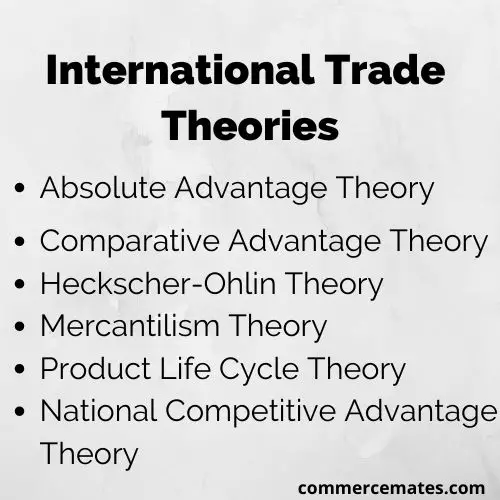Contents
Meaning of International Trade Theories
International trade theories are various theories that analyze and explain the patterns of international trade. These theories explain the mechanism of international trade that is how countries exchange goods and services with each other.
International trade refers to the trade that places across national borders. It is the means through which countries exchange goods with each other and is served as an important means of survival for many countries. Various countries that have limited resources depend on other countries to fulfilling their needs.
International trade theories help countries in deciding what should be imported and what should be exported, in what quantity and with whom trade should be done internationally. Initially, economists developed international trade theories on the basis of the country which were termed as classical theories. However, these theories, later on, shifted from country-based to firm or company based by the mid-twentieth century which was termed as modern theories. Different international theories are explained in detail as given below:-
International Trade Theories

Absolute Advantage Theory
Absolute advantage theory was proposed by Scottish social scientist Adam smith in 1776. This theory says that countries should focus on producing such products that they can produce efficiently at a lower cost as compared to other countries. Manufacturing a product in which a particular country specializes is quite advantageous for them. Countries should produce and export such products which can produce efficiently and import those goods that they produce relatively less efficiently. This kind of trade will be beneficial for both countries.
Comparative Advantage Theory
David Ricardo in 1817 has given the comparative advantage theory. According to this theory, If a country cannot produce goods more efficiently than other countries then it should only produce such goods in which it is most efficient. Countries should specialize and export such products in which it has a less absolute disadvantage as compared to other products.
Heckscher-Ohlin Theory
Heckscher-Ohlin theory of international trade was given by Eli Heckscher and Bertil Ohlin. It is also called as factors proportions theory and states that the country will produce and export those products whose production require those factory which are in great supply in-country and have low manufacturing cost. Whereas it will import all such goods whose production requires nation’s scarce and expensive factors and have high demand. According to this theory, trade patterns are recognized by factor endowment rather than productivity. The cost of any factor or resource is simply the function of demand and supply.
Mercantilism Theory
It is one of the oldest international trade theory which was developed in 1630. Mercantilism theory states that nation’s wealth is determined by its gold and silver holdings. Every nation in order to increase its economic strength should increase it’s gold and silver accumulation. It says that nations should favor export which leads to inflow of gold whereas they should disfavor import which lead to the outflow of gold. Mercantilism theory focuses on creating a trade surplus that is more exports than imports which will contribute to the accumulation of the nation’s wealth.
Product Life Cycle Theory
Product life cycle theory was developed in 1970 by Raymond Vernon, a Harvard Business School professor. It says that initially new products will be produced and exported from the home country of its innovation. Later on, when demand for the product grows country will undertake foreign direct investment in other countries and open several manufacturing plants to meet the request. Both locations of production and sales of product changes along with its life cycle or as product get matured.
National Competitive Advantage Theory
It was developed in 1990 by Harvard business school professor, Michael porter. This theory state that national competitiveness in a particular industry will depend upon the environment that such industry is getting in the home country. The main source of innovation and up-gradation for such industry is basically the environment in which they operate which helps countries in getting a national competitive advantage. Porter determined four factors as determinants of national competitive advantage of the nation. Local market resources and capabilities, Local market demand, Local suppliers and complementary industries and characteristics of local firms.